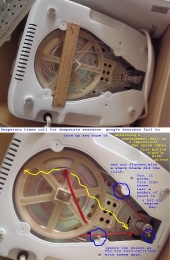So I continued to procrastinate more than I worked on that tractor. Even when I had to start collecting eggs from the brooder. A kid from church was looking for odd jobs, so he finished skinning it. I spent a day going over it, "sowing" the seams together with electric fence wire. When I got done, I don't think a bluejay could've gotten in. I moved 'em in.
The next day, my son gets my attention after work and says the chickens all appear to be dead. We both overlooked a vulnerability: the bottom of the gate could be bent up enough for a small predator to enter. One hen was alive but wouldn't stand. We figured she wouldn't last, but wanted to let her try, so we moved the old too small chicken tractor against the door to block it.
Later in the day I heard barking, so I quietly went to the door and watched. (The neighbor dogs come over, but they don't trust us, so they stay away from us and eventually go home if they know we're around.) As I watched, a small one of unknown (to me) breed, built kinda like a dachshund but fluffier, came and circled the tractor for five to ten minutes, and seemed to me to pay extra attention to the area where we blocked access to the door. I think I've found my culprit.
The hen we were still trying to protect died around dark. Final count: 9 dead, 2 missing. The 2 were probably drug off, but it's possible they got away and hid in a tree or in the bamboo. No known survivors.
My plan isn't completely formed, but I think it will involve stiffening the door. Motion lights mounted on the tractor? I think it will involve a goose and one chicken, probably a hen to keep it company. Small investment until I have more confidence in my tractor.
I have a few questions I'd like opinions on. Do I want to keep something in the tractor the dogs will want, so they help me with testing? Or does that just reinforce a habit that needs to be broken? Should I get my goose and chicken right away, or wait until spring? (First frost here is Halloween, give or take a week or two.)







